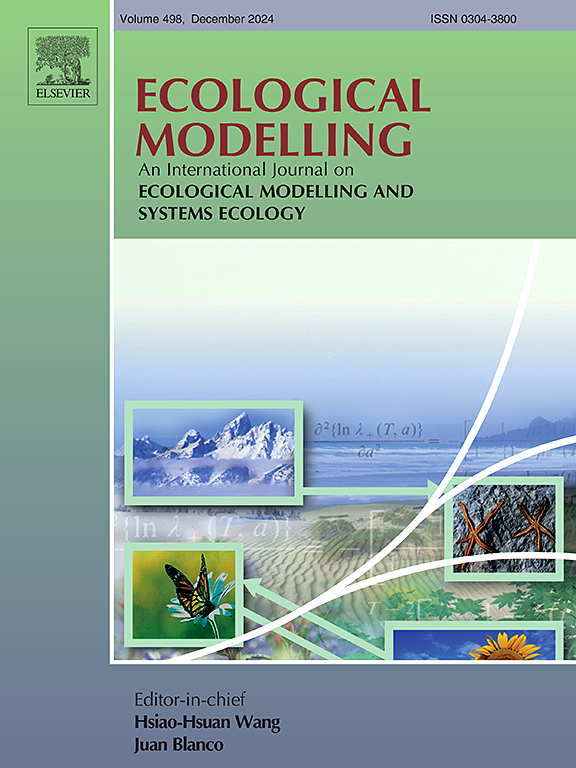Ecotracer set up to trace microplastics up the Black Sea marine food web
IF 3.2
3区 环境科学与生态学
Q2 ECOLOGY
引用次数: 0
Abstract
Around 70 % of all litter in the sea is plastic that, rather than decomposing, breaks down into ever-smaller pieces that can be ingested by marine organisms. However, we lack an understanding of consumption risk by marine species. In this study, particles of microplastic (MP) were traced-up the Black Sea food web, through the calibration process of the Ecotracer module against species-specific MP stomach content observations. These observations, were collected through a literature review: records of MP ingestion for over 60,000 individuals across 780 species within fish and invertebrates were gathered. Statistical analysis, performed on these records, revealed that MP uptake was higher in species inhabiting the Indian Ocean, the Caspian and the China seas. The calibration of the MP model, showed that, at steady state, small benthic and pelagic primary consumers showed the highest concentrations of MP per unit of biomass, led by high direct environmental uptake, and potentially as a consequence of MP bioaccumulation. Secondary consumers, at higher trophic levels, revealed higher MP trophic uptake (biomagnification through diet). Differences in Ecotracer set-up and the calibration procedures were discussed across other recent publications addressing plastic pollution in food-webs. The results were interpreted in relation to species ecological behaviors and physiological characteristics. The approach here, presented with the accessible global database on MP in stomach contents, aims to be a reference for setting up and calibrating MP in food webs.

生态追踪器用来追踪黑海海洋食物网中的微塑料
海洋中大约70%的垃圾是塑料,它们不会分解,而是分解成更小的碎片,可以被海洋生物吸收。然而,我们对海洋物种的消费风险缺乏了解。在本研究中,通过Ecotracer模块对特定物种的微塑料(MP)胃含量观察的校准过程,追踪黑海食物网中的微塑料(MP)颗粒。这些观察结果是通过文献综述收集的:收集了780种鱼类和无脊椎动物中60000多个个体的MP摄入记录。对这些记录进行的统计分析显示,生活在印度洋、里海和中国海的物种对多氯丁酸的吸收更高。MP模型的校准表明,在稳定状态下,小型底栖和远洋主要消费者显示出每单位生物量中最高的MP浓度,这是由高直接环境吸收引起的,并且可能是MP生物积累的结果。二级消费者,在更高的营养水平,显示更高的MP营养摄取(通过饮食的生物放大)。生态示踪剂设置和校准程序的差异在其他最近的出版物中讨论了食物网中的塑料污染。结果与物种的生态行为和生理特征有关。这里的方法,与胃内容物中可访问的MP全球数据库一起提出,旨在为建立和校准食物网中的MP提供参考。
本文章由计算机程序翻译,如有差异,请以英文原文为准。
求助全文
约1分钟内获得全文
求助全文
来源期刊

Ecological Modelling
环境科学-生态学
CiteScore
5.60
自引率
6.50%
发文量
259
审稿时长
69 days
期刊介绍:
The journal is concerned with the use of mathematical models and systems analysis for the description of ecological processes and for the sustainable management of resources. Human activity and well-being are dependent on and integrated with the functioning of ecosystems and the services they provide. We aim to understand these basic ecosystem functions using mathematical and conceptual modelling, systems analysis, thermodynamics, computer simulations, and ecological theory. This leads to a preference for process-based models embedded in theory with explicit causative agents as opposed to strictly statistical or correlative descriptions. These modelling methods can be applied to a wide spectrum of issues ranging from basic ecology to human ecology to socio-ecological systems. The journal welcomes research articles, short communications, review articles, letters to the editor, book reviews, and other communications. The journal also supports the activities of the [International Society of Ecological Modelling (ISEM)](http://www.isemna.org/).
 求助内容:
求助内容: 应助结果提醒方式:
应助结果提醒方式:


